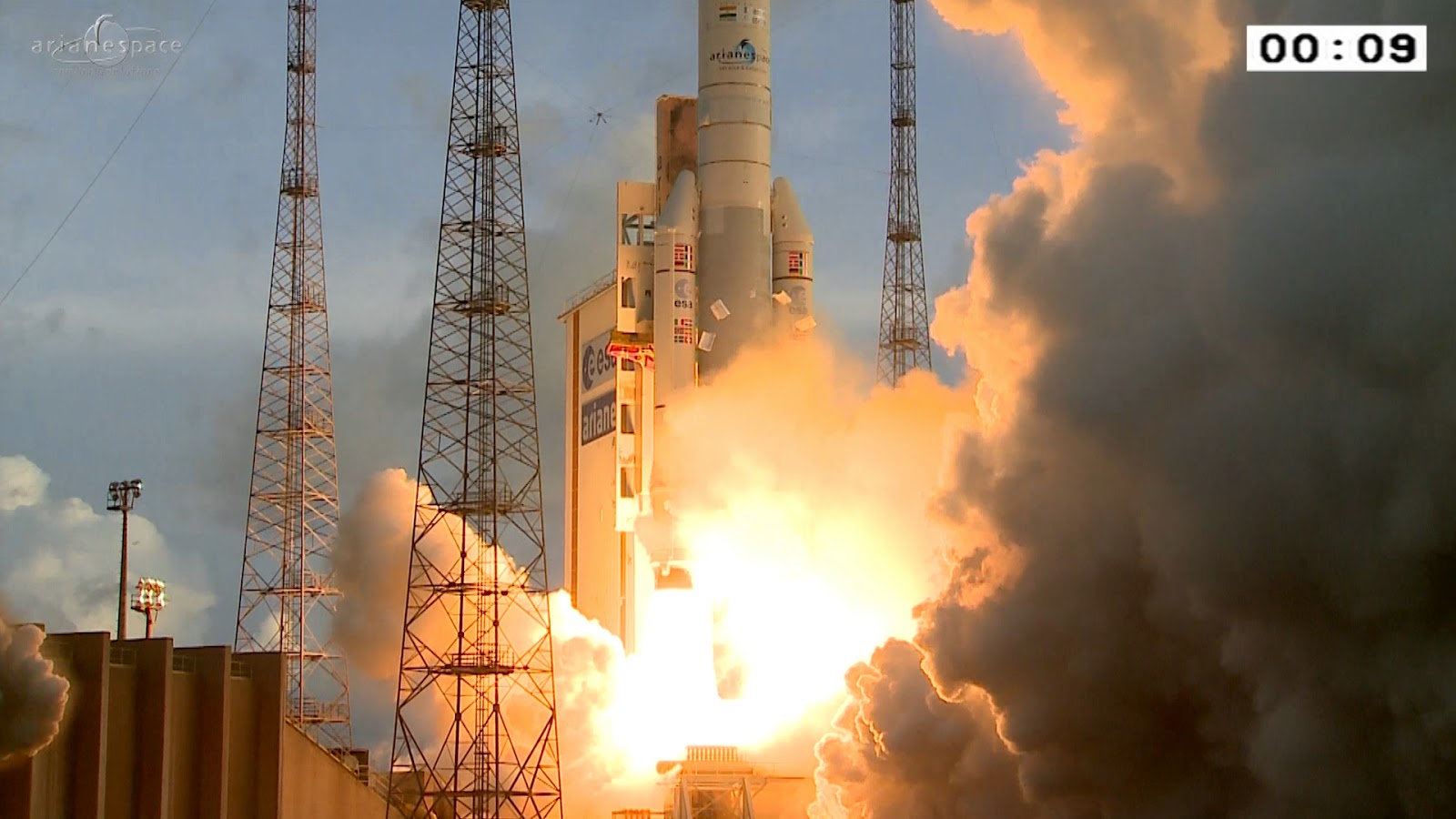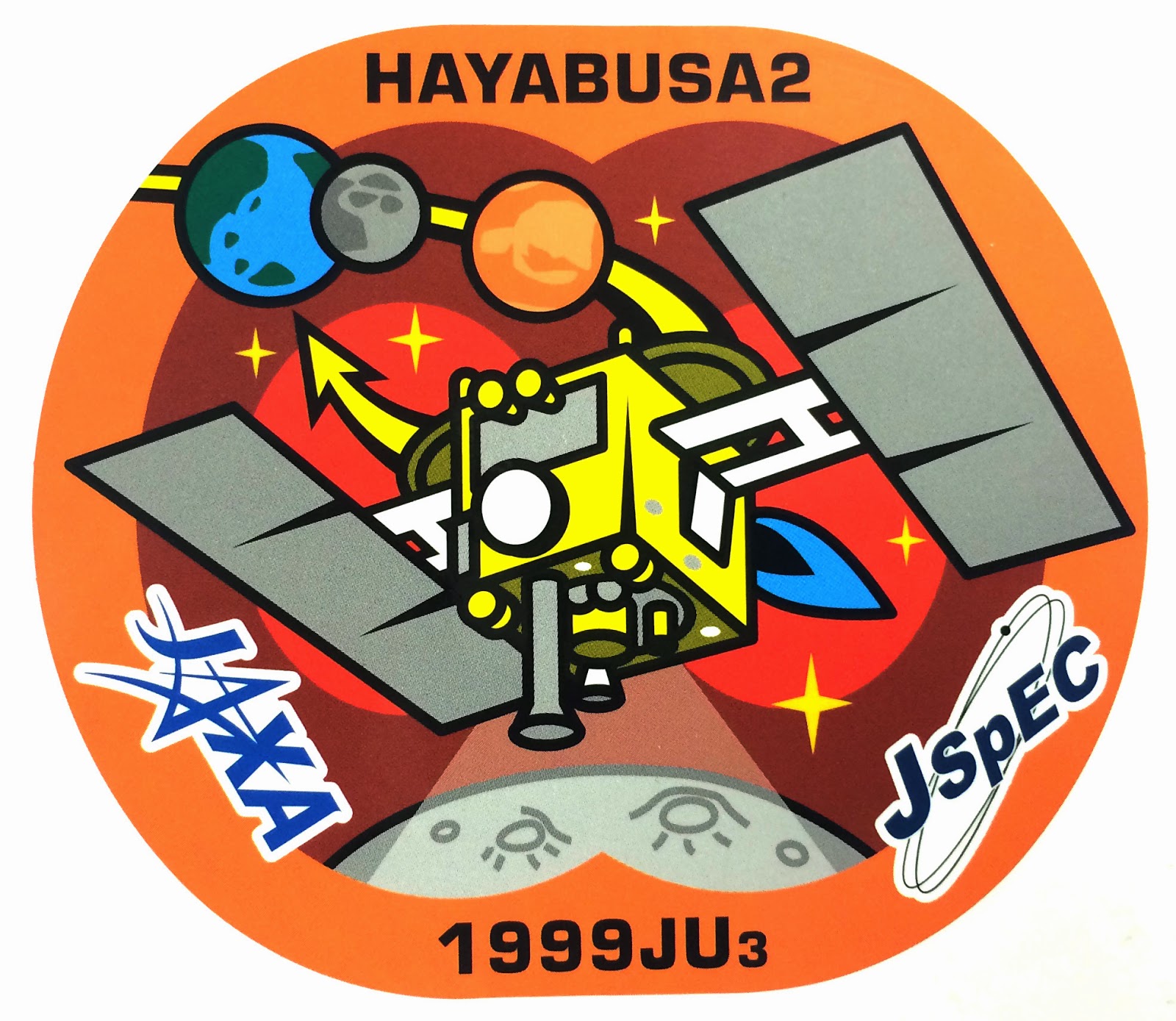ESA - Galileo Navigation Satellites logo.
3 December 2014
Europe’s fifth Galileo satellite, one of two delivered into a wrong orbit by VS09 Soyuz-Fregat launcher in August, has transmitted its first navigation signal in space on Saturday 29 November 2014. It has reached its new target orbit and its navigation payload has been successfully switched on.
Galileo satellite
A detailed test campaign is under way now the satellite has reached a more suitable orbit for navigation purposes.
RecoveryThe fifth and sixth Galileo satellites, launched together on 22 August, ended up in an elongated orbit travelling up to 25 900 km above Earth and back down to 13 713 km.
A total of 11 manoeuvres were performed across 17 days, gradually nudging the fifth satellite upwards at the lowest point of its orbit.
As a result, it has risen more than 3500 km and its elliptical orbit has become more circular.
“The manoeuvres were all normal, with excellent performance both in terms of thrust and direction,” explained Daniel Navarro-Reyes, ESA Galileo mission analyst.
Galileo satellite's revised orbit
The commands were issued from the Galileo Control Centre by Space Opal, the Galileo operator, at Oberpfaffenhofen in Germany, guided by calculations from a combined flight dynamics team of ESA’s Space Operations Centre, ESOC, in Darmstadt, Germany and France’s CNES space agency.
The commands were uploaded to the satellite via an extended network of ground stations, made up of Galileo stations and additional sites coordinated by France’s CNES space agency.
Satellite manufacturer OHB also provided expertise throughout the recovery, helping to adapt the flight procedures.
Until the manoeuvres started, the combined ESA–CNES team maintained the satellites pointing at the Sun using their gyroscopes and solar sensors. This kept the satellites steady in space but their navigation payloads could not be used reliably.
In the new orbit, the satellite’s radiation exposure has also been greatly reduced, ensuring reliable performance for the long term.
A suitable orbitThe revised, more circular orbit means the fifth satellite’s Earth sensor can be used continuously, keeping its main antenna oriented towards Earth and allowing its navigation payload to be switched on.
Significantly, the orbit means that it will now overfly the same location on the ground every 20 days. This compares to a normal Galileo repeat pattern of every 10 days, effectively synchronising its ground track with the rest of the Galileo constellation.
The navigation test campaignThe satellite’s navigation payload was activated on 29 November, to begin the full ‘In-Orbit Test’ campaign. This is being performed from ESA’s Redu centre in Belgium, where a 20 m-diameter antenna can study the strength and shape of the navigation signals at high resolution.
“First, the various payload elements, especially the Passive Hydrogen Maser atomic clock, were warmed up, then the payload’s first ‘signal in space’ was transmitted,” said David Sanchez-Cabezudo, managing the test campaign.
Controlling Galileo
“The satellite-broadcast L-band navigation signal is monitored using the large antenna at Redu, with experts from OHB and Surrey Satellite Technology Ltd – the payload manufacturer, based in Guildford, UK – also on hand to analyse how it performs over time.”
The first Galileo FOC navigation signal-in-space transmitting in the three Galileo frequency bands (E5/E6/L1) was tracked by Galileo Test User Receivers deployed at various locations in Europe, namely at Redu (B), ESTEC (NL), Weilheim (D) and Rome (I). The quality of the signal is good and in line with expectations.
The Search And Rescue (SAR) payload will be switched on in few days in order to complement the in-orbit test campaign.
The way forward
The same recovery manoeuvres are planned for the sixth satellite, taking it into the same orbital plane but on the opposite side of Earth.
Galileo L-band antenna at Redu
The decision whether to use the two satellites for Navigation and SAR purposes as part of the Galileo constellation will be taken by the European Commission based on the test results.
About Galileo
Galileo is Europe’s own global satellite navigation system. It will consist of 30 satellites and their ground infrastructure.
The definition phase and the development and In-Orbit Validation phase of the Galileo programme were carried out by the European Space Agency (ESA) and co-funded by ESA and the European Union. This phase has created a mini-constellation of four satellites and a reduced ground segment dedicated to validating the overall concept.
Full Galileo constellation
The four satellites launched during the IOV phase form the core of the constellation that is being extended to reach Full Operational Capability (FOC).
The FOC phase is fully funded by the European Commission. The Commission and ESA have signed a delegation agreement by which ESA acts as design and procurement agent on behalf of the Commission.
Learn more about Galileo at:
http://www.esa.int/Our_Activities/Navigation About the European Space AgencyThe European Space Agency (ESA) provides Europe’s gateway to space.
ESA is an intergovernmental organisation, created in 1975, with the mission to shape the development of Europe’s space capability and ensure that investment in space delivers benefits to the citizens of Europe and the world.
ESA has 20 Member States: Austria, Belgium, the Czech Republic, Denmark, Finland, France, Germany, Greece, Ireland, Italy, Luxembourg, the Netherlands, Norway, Poland, Portugal, Romania, Spain, Sweden, Switzerland and the United Kingdom, of whom 18 are Member States of the EU. Two other Member States of the EU, Hungary and Estonia, are likely soon to become new ESA Member States.
ESA has Cooperation Agreements with six other Member States of the EU. Canada takes part in some ESA programmes under a Cooperation Agreement.
ESA is also working with the EU on implementing the Galileo and Copernicus programmes.
By coordinating the financial and intellectual resources of its members, ESA can undertake programmes and activities far beyond the scope of any single European country.
ESA develops the launchers, spacecraft and ground facilities needed to keep Europe at the forefront of global space activities.
Today, it develops and launches satellites for Earth observation, navigation, telecommunications and astronomy, sends probes to the far reaches of the Solar System and cooperates in the human exploration of space.
Learn more about ESA at
http://www.esa.int Related links:ESOC - European Space Operations Centre:
http://www.esa.int/About_Us/ESOCTeam of teams:
http://www.esa.int/Our_Activities/Operations/Highlights/Team_of_teamsFlight Dynamics:
http://www.esa.int/Our_Activities/Operations/Ground_Systems_Engineering/Flight_DynamicsImages, Text, Credits: ESA/P. Carril.
Cheers, Orbiter.ch





















































